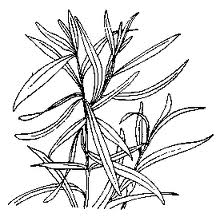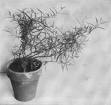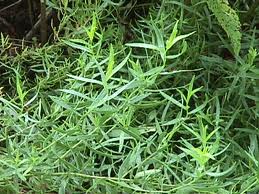French Tarragon (Artemisia dracunculus)
 Referred as “a chef’s best friend,” French Tarragon (Artemisia dracunculus) is an essential aromatic herb. French tarragon may be grown as an annual or as a perennial, as it is winter hardy to zone 4. Depending on the climate, it may be necessary to cover French tarragon with mulch during the winter, when grown as a perennial. Avoid Russian tarragon which has inferior flavor to the French tarragon; many seed packets labeled as “tarragon” are really Russian tarragon. Buy French Tarragon as seedlings. Russian tarragon, Artemisia dracunculoides, is much coarser, has paler leaves, and a more bitter taste.
Referred as “a chef’s best friend,” French Tarragon (Artemisia dracunculus) is an essential aromatic herb. French tarragon may be grown as an annual or as a perennial, as it is winter hardy to zone 4. Depending on the climate, it may be necessary to cover French tarragon with mulch during the winter, when grown as a perennial. Avoid Russian tarragon which has inferior flavor to the French tarragon; many seed packets labeled as “tarragon” are really Russian tarragon. Buy French Tarragon as seedlings. Russian tarragon, Artemisia dracunculoides, is much coarser, has paler leaves, and a more bitter taste.
Planting French Tarragon
 French tarragon prefers full sun, well-drained soils, grows to a height of 24 to 36 inches with a 12 to 15 inch spread.
French tarragon prefers full sun, well-drained soils, grows to a height of 24 to 36 inches with a 12 to 15 inch spread.
Since French tarragon cannot be propagated by seed, it must be reproduced vegetatively. Division of old plants is the preferred method. This is best done in the spring as the new shoots are forming. Cuttings can also be taken, but they are slow to root and not entirely depend- able.
Soil: French tarragon grows best in warm, dry, well-aerated soils and does not tolerate wet or saturated soils. French tarragon grows well in neutral pH soils (pH 6.5-7.5), but exhibits some preference for slightly acidic soils. Most soils in Utah are suitable for growing French tarragon provided they are well drained.
Transplant French tarragon in the spring, after the last frost, to ensure the survival of tender young shoots. French tarragon prefers full sun and warm but not hot temperatures.
Plant French tarragon 24 inches apart and keep it trimmed to maintain its form. Divide plants in spring to maintain plant vigor. French tarragon should be renovated every 2 to 3 years to maintain flavor and vigorous growth.
Care Of French Tarragon
 In areas where summer temperatures exceed 90° F, partial shading of French tarragon increases plant survival.
In areas where summer temperatures exceed 90° F, partial shading of French tarragon increases plant survival.
Water: French tarragon performs best when the soil is allowed to dry between irrigations. Mulch around the plants to retain moisture near the soil surface, since tarragon has shallow roots. Over-watering or poor soil drainage encourages root rot. Water new plants frequently until established, and water existing plants once a week.
Fertilizing: French tarragon has low fertilizer requirements. As with many herbs, the tarragon flavor is intensified when grown in nutrient poor soils so only fertilize when planting.
Over-wintering: When growing tarragon as a perennial, shear plants to the ground after frost has killed top growth and mulch heavily before winter to ensure survival. French tarragon can be grown as a potted plant. After the fall harvest, bring the plant indoors, water and fertilize to stimulate growth and locate where the plant will get 6 hours of direct sunlight each day.
Month To Month Care Of Tarragon
Month of March - Tarragon – If you have a plant already in the garden, tarragon likes to be divided every three years or so. Do this any time in April or early May.
Month of April - Tarragon – Buy seedlings/transplants from the garden center and plant them when all danger of frost is past. All two square feet of space per plant.
Month of May - Tarragon – Optional - Tarragon can grow to be two feet tall. Stakes can help keep it from flopping over.
Month of June Tarragon – Pick tarragon leaves any time. For best flavor pick them in the morning.
Optional – You can cut the whole plant back to about 6 inches to stimulate new growth.
Month of July - Tarragon – Optional – Remove all flower stems as they appear to keep the plant productive.
Month of August
Month of September
Month of October - Tarragon – Tarragon is a perennial which dies back over the winter and comes back in the spring. It is wise to mulch the plant with 2 to 3 inches of organic material over the winter.
Occasional Problems of Tarragon
Insects/Diseases: French tarragon is generally insect and disease free. French tarragon is susceptible to root rot if over watered and/or subjected to poorly drained soils.
Harvest and Storage of Tarragon
Harvest six to eight weeks after planting and until leaves turn yellow in the fall. French tarragon is generally used as a fresh herb and sprigs may be harvested as needed throughout the growing season. A sprig is typically one-third the length of the stem.
Cooking With Tarragon
Kuchenprofi No-Mess Herb Grinding Mill
by Kuchenprofi
• The effortless way to chop fresh herbs; pop leaves and sprigs into the hopper, turn the crank and internal blades do the chopping
• Screw-off jar
• No exposed blades; no nicked fingers; no tired wrists
• 18/10 stainless steel hopper and lid; 6-3/4 inches high by 3-3/4 inch diameter
• Dishwasher safe
Chop fresh herbs without a knife! Simply pop leaves and sprigs into the hopper of the Kuchenprofi Herb Grinding Mill, turn the crank and internal blades do all the chopping for you, depositing evenly minced results into the screw-off jar below. No sharp blades, nicked fingers or tired wrists! Dishwasher safe 6-3/4-inch high by 3-3/4-inch diameter.
French tarragon is used to create vinegars and flavor fish, but is also commonly used to flavor vegetables and meats (shellfish, poultry, and lamb). This is considered to be one of the truly “fine” herbs. It has a characteristic licorice like fragrance that is not as strong in the dried leaves. It is essential in tartar sauce and bearnaise sauce and enhances fish, pork, lamb, game, poultry, and many vegetables. Use with discretion so that it doesn’t become overpowering; also avoid cooking it too long or a bitter flavor will result.

